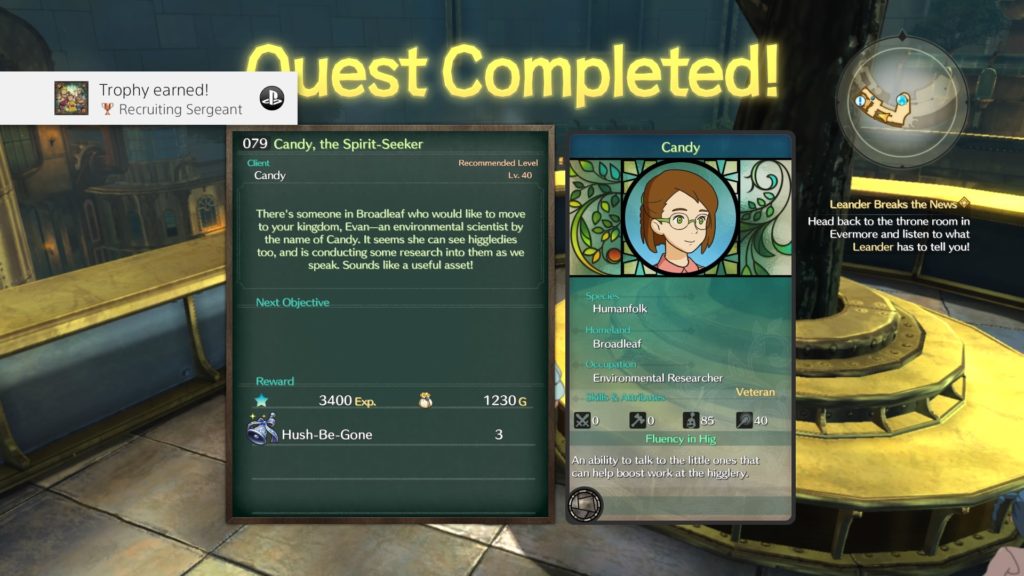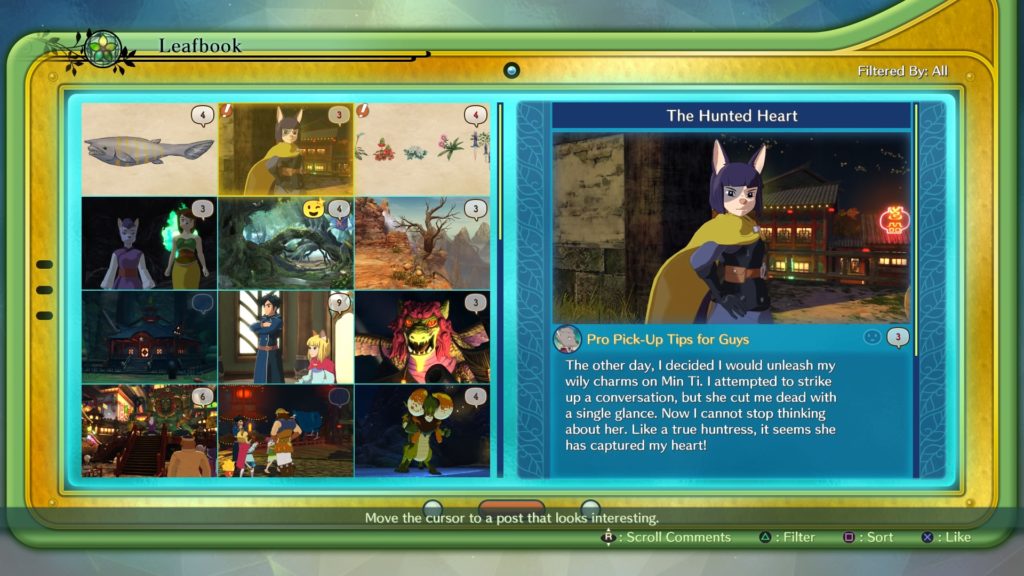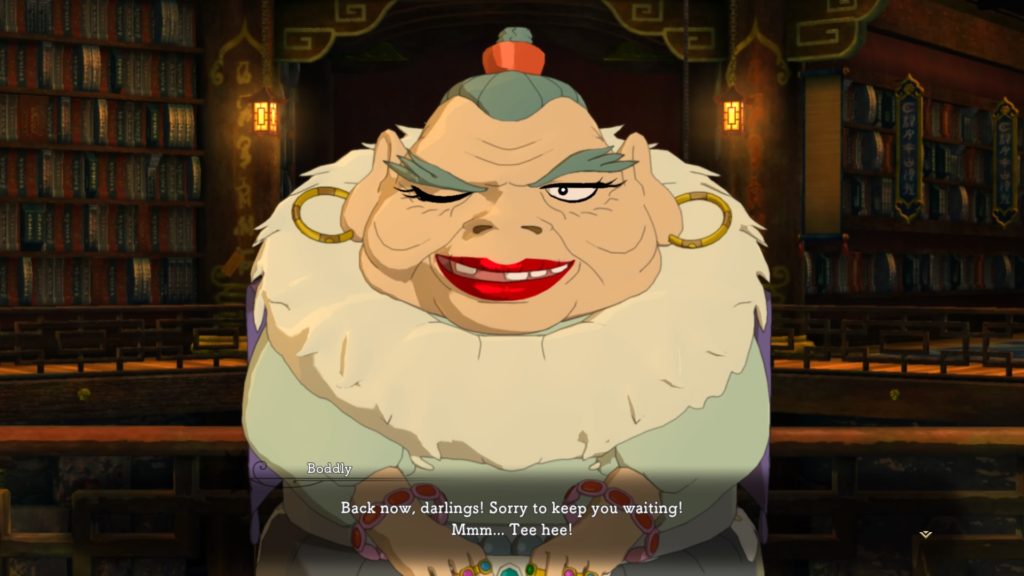After a coup exiles Evan from his nation, he sets out to create his own kingdom as a promise to a friend. Along the way he’ll meet many new friends and find out what is actually happening out in the world.

Ni No Kuni II: Revenant Kingdom is the long awaited sequel to Ni No Kuni: Wrath of the White Witch for PS3. Breaking from the original game, Ni No Kuni II offers a fresh look into the series with revamped combat and an all new story. As someone who quite enjoyed the first game it didn’t take much convincing for me want to play Ni No Kuni II. Was it worth it? Well… Let’s talk about that!
The story of Ni No Kuni II: Revenant Kingdom follows the stories of Evan and Roland. Evan has been forced out of his home kingdom, Ding Dong Dell, due to a coup by his late father’s advisor. Roland is the President of some country who was mysterious transported to this world for unknown reasons. After their grand escape, they set out to form a new country after recruiting on a kingsmaker – the mark of a king – named Lofty.
As they set out to try and unite the great nations they meet many new friends and recruit on residents for their kingdom. This recruiting is done through a variety of side quests that will send you all over the world hunting down monsters or items. Not all side quests lead to the recruitment of new citizens, although they often will be in a quest chain towards new ones (especially since there is 100 citizens for you to recruit for you kingdom).

Side quests get extremely same-y and you just get overloaded with them. From my last count, I saw that there was around 170 side quests in the game. Almost every single one of these boils down to one of two things – fetch X item or kill Y enemy, which oftentimes is located in some random cave that looks exactly like every other cave you visit.
While at first it can be fun to track all these quests down and do them, it eventually just becomes a huge drag. It doesn’t help that you can only track one quest at a time, so you either need an extremely good memory or you have to go through a ton of different menus to constantly check out and swap between the quests. Oh, and it always changes back to your main quest after you finish one, so to even start tracking a new one you have to go into the menu anyways.
Speaking of menus, get ready to be digging through a TON of them in Ni No Kuni II. From the equipment screen you’ll have to sort through the fact that every character can equip three weapons at once – more on that later – to equipping their ranged weapon to their armour. Luckily for all but the accessory slots (necklace and ring) you can just do a “equip the best in this slot” click and be done with it if you don’t feel like digging through the lists yourself. Of course, at least on the English translation, you’ll need to ignore that the Optimize part is a bit buggy and doesn’t properly list the character names.

Also in the menu you will find the Tactic Tweaker – a way to make adjustments to your game to altar how some things will go. Want to do more damage against a particular type of enemy? You can adjust that… once you level it up. You gain points to level up the Tactic Tweaker by leveling up your characters. As you level up the various categories you’ll be able to invest more points into each one until you hit the cap for that particular category.
The thing is, I found that the game is a bit lacking in their explanations of what some things do and that the UI just lacks proper feedback unless you dig through even more menus. For example, one of the options in the Tactic Tweaker is the “Spoils Settings”. This option lets you adjust how much experience, money, and how much rare equipment/items you receive. You can level up this particular setting four times – one time for each slider. When you actually start fiddling around with the sliders, you’ll find that the help box for this only ever states “Lv. 1 boost” even if you have two sliders pointing towards the same option. If you look in your “View Effects” menu list, you’ll see that you do actually gain a level 2 boost to said option if you have two sliders pointing towards it.
Ni No Kuni II also has a Library you can look through to find various information regarding the game, but the biggest feature of this is the Leafbook (also accessible by pressing L3). Leafbook is Ni No Kuni II’s Facebook essentially, right down to the part where pictures are shown of your party as they do key moments that you would’ve thought were private. Almost as if starting the trend of how features go in Ni No Kuni II, the Leafbook is cool at first – you can look through the posts and see the comments on them… but then it starts getting updated for every other side quest you complete. It becomes so completely overwhelming that I ended up just ignoring it for the second half of the game. You also can’t even get a good view of the pictures on there, so for the posts that are all about “Look at this pretty art!” you don’t actually get a nice big view of said art.

One of the biggest features in the game is the kingdom building part. Well, it’s more-so just another menu simulator. Find the building placement on the map, spend your kingsguilders to build it, set citizens to work there, start research if available, rinse, repeat. Kingsguilders – and items from the different kinds of item gathering locations – are gained over time as your citizens work at your facilities, or in other words as game time passes. Do keep in mind that you do have a max capacity that can be increased by spending some kingsguilders, or by conducting the appropriate research at the Explorer’s Guild.
The problem with the kingdom building is the problem a lot of the game suffers… It gets so same-y, and as your kingdom grows you’ll spend more time hunting around and digging through menus to get everything done than you do anything else. Have a quest from a citizen? Have fun finding your way around the map, especially as you get a larger and larger kingdom.
Compared to the original Ni No Kuni, Revenant Kingdom has completely revamped the combat. This time around you have a fully active battle system that is far too easy with no difficulty settings in sight. The first half of the game will leave you wondering if that fight you just finished was actually a boss fight, and the second half (well, mainly the last couple chapters) you get a false difficulty in enemies just doing cheap shots at you. Yes, I greatly appreciated that Tainted enemy (essentially your “Notorious Monsters”) smacking me for 1500 damage when I was down to 1497 health. Thanks. The Tactics Tweaker only serves to make the easy battles even easier, and even when some bosses try and find a way to make them difficult (outside of cheap shots), all they really are doing is making the fight take longer which isn’t a “fun” way to add difficulty. Also, get used to fighting the same, exact enemies the entire game, because almost every single enemy (outside of certain key boss fights) are just reskins.
One thing you learn very quickly on with battles is that you are going to get showered with a lot of equipment drops. I mean, you do have three different weapons you have equipped at once that you can change through to get more powerful skills, but there is a lot of equipment that drops. At first, like many other things, I was eagerly checking to see if that new sword I got was an upgrade, but it eventually came to the point that I wouldn’t check for entire dungeon and then would find I had a new weapon that was 40 points of damage above what I already had. The pure inundation of equipment you get is just a bit over the top and almost none of it is even worth even bothering to check.

Want a break from the combat? Why not try out a Skirmish! In this RTS-like setting, you go into mini-battles with your troops – four different squads from your kingdom – to take out the big, bad evil guys trying to do evil things in that area. Much like everything else though… These get extremely dull and repetitive, and on top of that I still don’t know half of what I’m actually supposed to do in them. The tutorial is pretty poorly worded and I ended up just throwing my guys in and hoping for the best.
One thing Skirmishes do very well though is drive home the point that the voice acting was so bare bones. If I have to hear “FORWARD!” or “CHAARRRGE!” one more time I think I might scream. As I played through the game, the voice acting became less and less prevalent that extremely important story moments were not voiced at all outside of just general lines such as “Golly…” or “Excuse me!” Heck, at one point in the ending it becomes unvoiced during a time that is one of the most important sections of the ending. For me it just became a running joke that the more important a scene was the less it was voice acted. That said, what voice acting was present was well done… well, okay, Lofty got annoying because I couldn’t understand 95% of what he said, but besides him. Long story short: pay your voice actors and get proper voicing in for your games if you want it in a game like this.

The music of Ni No Kuni II: Revenant Kingdom is nothing to really write home about. Most of the songs just end up getting annoying and there was very few tracks I actually enjoyed. One of the most annoying tracks, at least to me, was the music that plays within Goldpaw. You spend a ton of time there early on and it gets old really, really fast.
What really saddened me about Ni No Kuni II was the framerate. Now, I don’t know if it’s because I was playing the game on a regular PS4 or what, but I would frequently see framerate dips and stuttering happen, especially on the world map. At some points it became so painful to try and get through because the framerate would just suffer so much.
Ni No Kuni II: Revenant Kingdom starts out quite strong and then just drops the ball completely. You get introduced to a lot of different systems and then that’s it. Nothing changes. It eventually becomes a giant chore, and it’s quite likely you’ll end up hitting the point of “enough side stuff, I just want to beat this game and be done”. I know I hit that point, and I even pushed myself to try and keep doing more side quests long after I had hit that point. If I were to have recommended this game just based on the start of it then I would have done so without question, but with having played it through I just can’t give it a recommendation. On top of all that, the frequent framerate issues I encountered really drove the nail into the coffin, but hopefully that’s something they can patch somewhere down the line.
If you’re in the market for a new RPG to play then I simply don’t recommend Ni No Kuni II: Revenant Kingdom unless you’re ready for a giant chore.
I played Ni No Kuni II: Revenant Kingdom on a regular PS4 so issues such as the framerate may vary on other systems.

